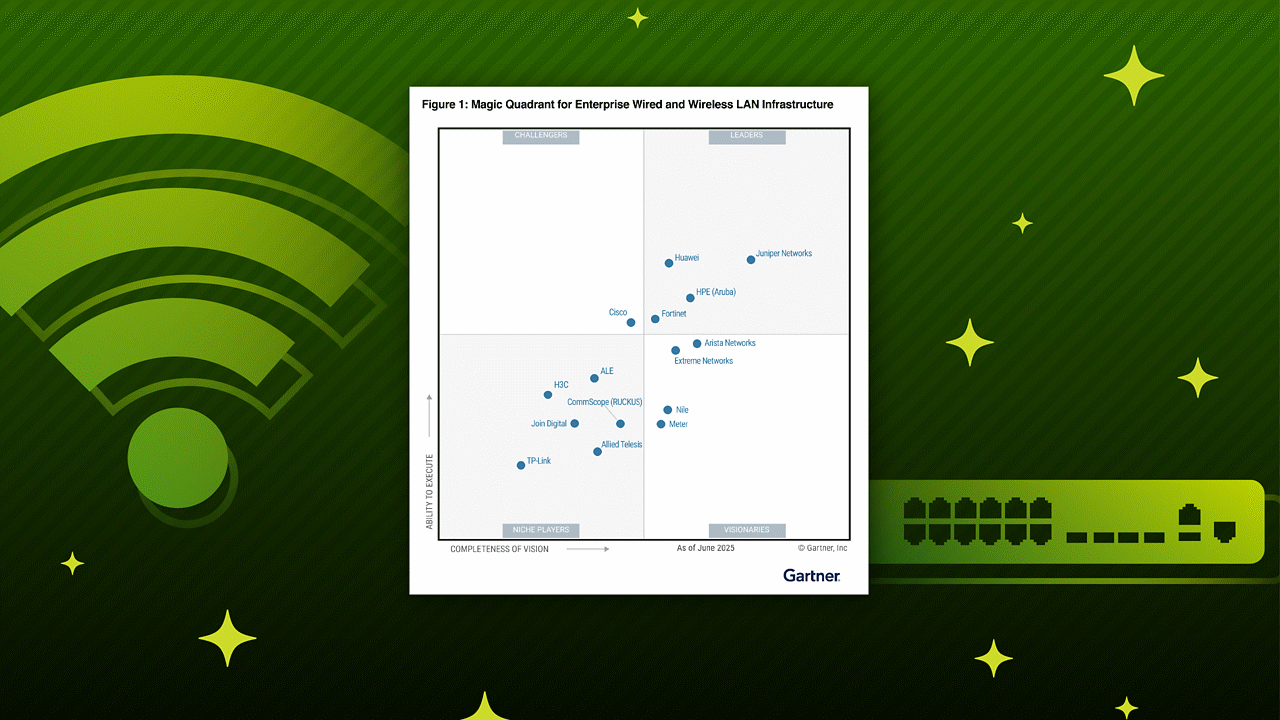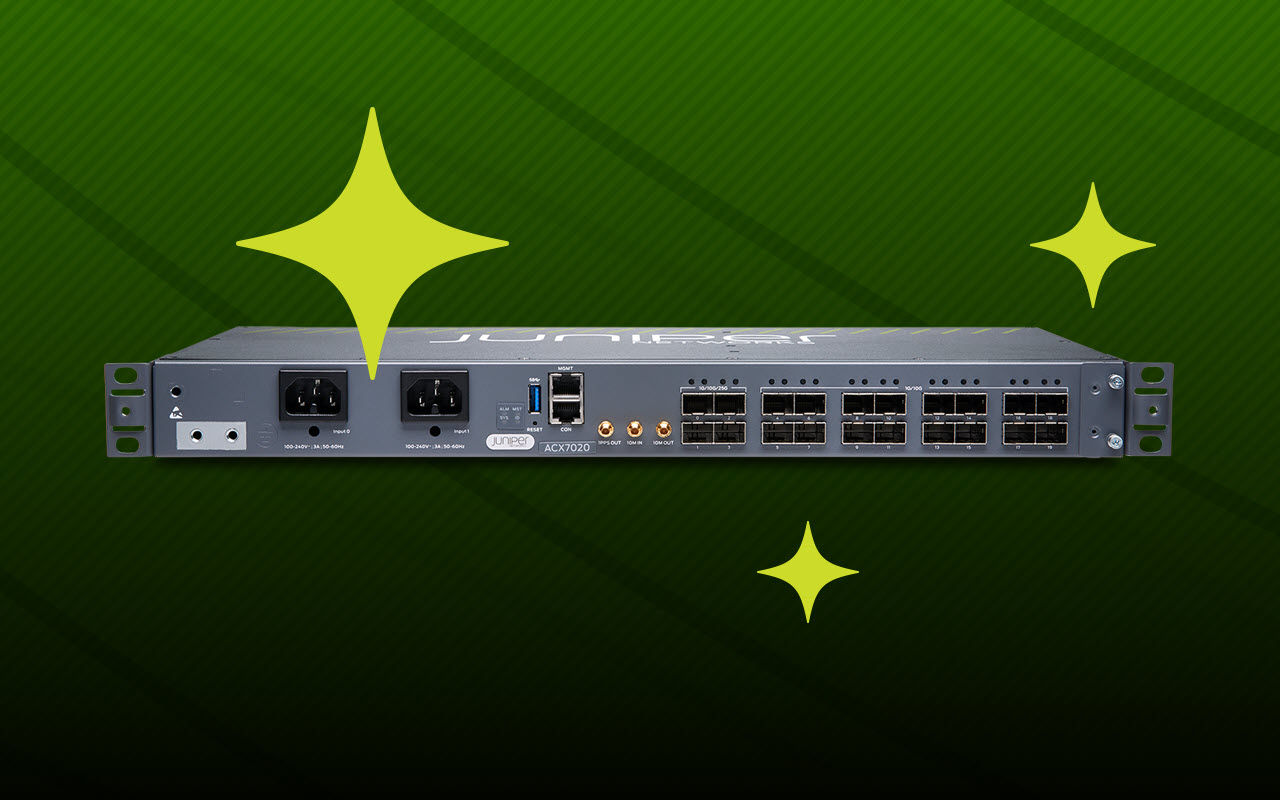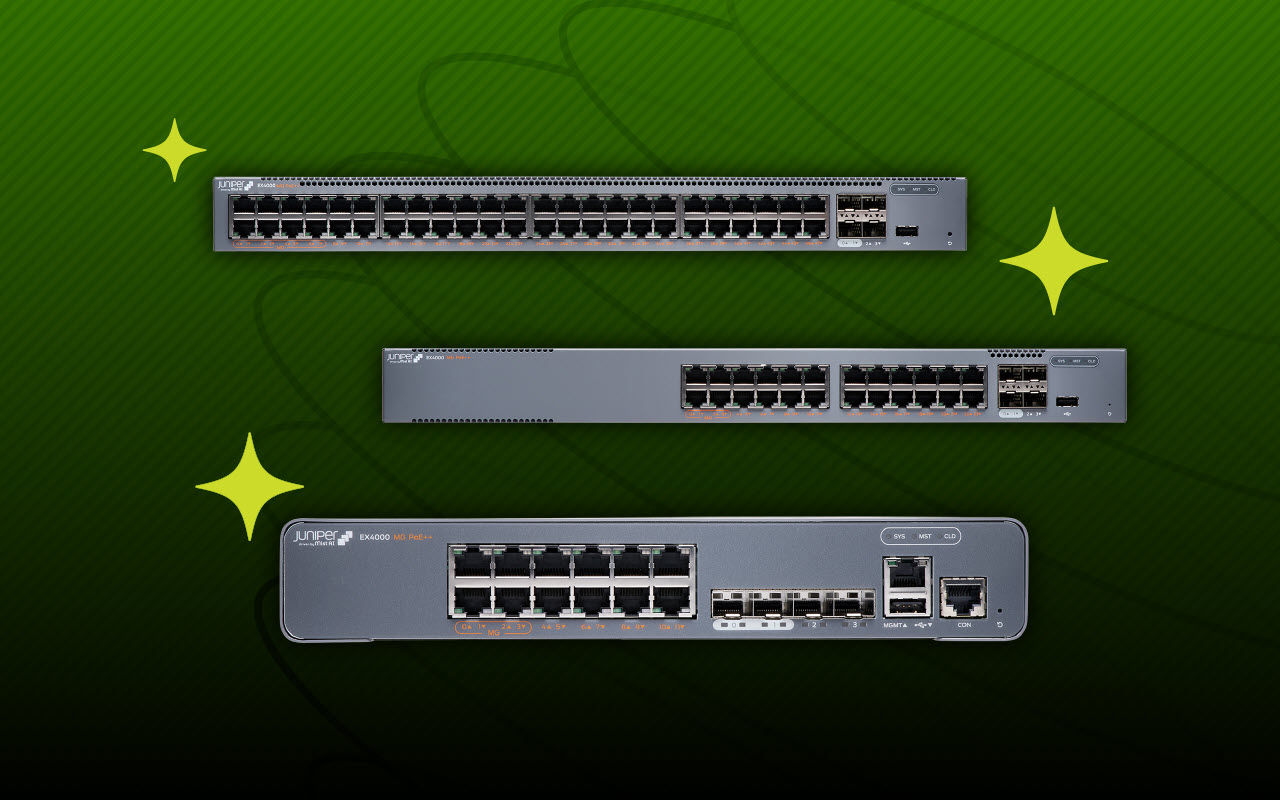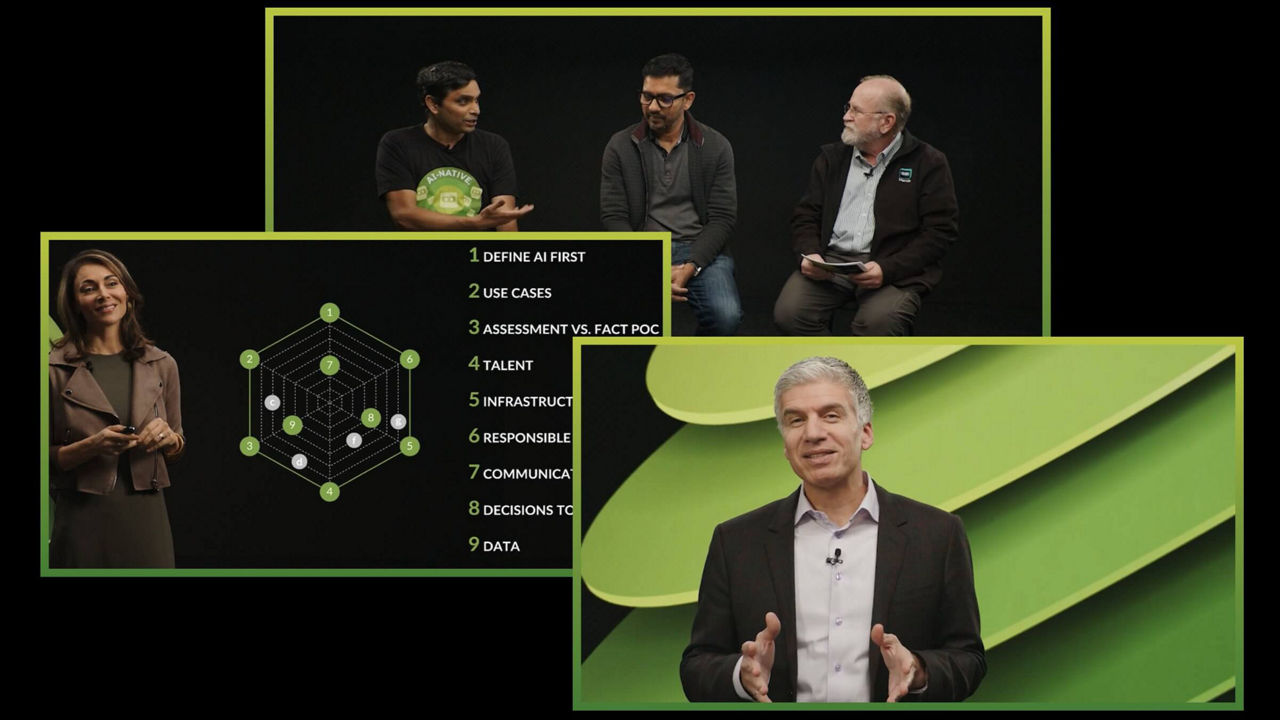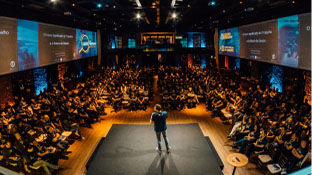QFX5210 Switch Datasheet
Download DatasheetProduct Overview
The QFX5210 Switch is a flexible, 64-port, fixed-configuration switch designed for spine-and-leaf applications in next-generation IP fabric networks. Featuring line-rate, high-density QSFP+/QSFP28 ports supporting 10GbE, 25GbE, 40GbE, and 100GbE connections, the QFX5210 offers an advanced Layer 2, Layer 3, and MPLS feature set. This allows network operators to build large, high-density IP fabrics that support network virtualization and intelligent traffic forwarding based on proven, Internet-scale technology, while enabling easy upgrades to 25GbE servers.

Product Description
Network operators are increasingly deploying scale-out spine-and-leaf IP fabric architectures built with fixed-configuration switches to support growing east-west traffic in the data center. The Juniper Networks® QFX5210 Switch is a next-generation, fixed-configuration spine/leaf switch that offers flexible, cost-effective, high-density 10GbE, 25GbE, 40GbE, and 100GbE interfaces for IP fabric networks, providing deployment versatility, investment protection, and future-proofing for today’s data centers. The QFX5210 Switch’s high port density also contributes to simplified Clos architectures, eliminating network tiers while reducing complexity and cost.
Like other Juniper Networks QFX Series Switches, the QFX5210 supports advanced L2, L3, and MPLS features. For large public cloud providers—among the first to adopt 25GbE servers to meet explosive workload growth—the QFX5210 enables very large, dense, and fast IP fabrics based on proven Internet scale technology.
The QFX5210 runs the same reliable, high-performance Junos® operating system used by network operators around the world.
QFX5210 Deployment Options
Table 1 shows some of the many QFX5210 deployment options, including top-of-rack access as well as spine-and-leaf configurations in a centralized or distributed gateway architecture.
| Port Combinations | Deployment |
| 64x100GbE | Spine/leaf |
| 96x25GbE + 8x100GbE | 25GbE access |
The QFX5210 can be positioned as a top-of-rack device in a centralized gateway architecture (also known as centrally routed bridging, or CRB). Figure 1 shows the QFX5210 deployed as an access switch with the Juniper Networks QFX10000 line of Switches acting as the spine device configured as a central gateway. In this topology, the QFX10000 can also be configured as a collapsed spine and edge device, acting as a central gateway for Ethernet VPN (EVPN)-Virtual Extensible LAN (VXLAN), MPLS, and other tunneling protocols. The 100GbE ports on the QFX5210 can be channelized to support 4x25GbE or 4x10GbE downlinks.

Figure 1: QFX5210 and QFX10002 in a leaf-spine deployment with centralized gateway
The QFX5210 can also be positioned as a lean spine device in a distributed gateway architecture (also known as edge-routed bridging, or ERB). Figure 2 shows QFX5120 switches deployed as access switches configured as distributed gateways and QFX5210 switches deployed as spine switches.

Figure 2: QFX5120 and QFX5210 leaf-spine deployment with distributed gateway
Architecture and Key Components
The QFX5210 is a compact, 2 U platform featuring 64 quad small form-factor pluggable plus (QSFP+) transceivers or QSFP28 ports, with two redundant 1100 W AC/DC power supplies and four fan trays.
A QSFP28 module can be used to provide a 1x100GbE connection or 4x25GbE connections using breakout cables. A QSFP+ module can be used to provide a 1x40GbE connection or 4x10GbE connections using breakout cables.
The QFX5210 features a high-throughput 12.8 Tbps Packet Forwarding Engine (PFE). Control plane performance is further enhanced with the Intel Broadwell-DE, 4 Core, 2.2 GHz CPU, and 16 GB DDR4, 100 GB SSD storage.
The QFX5210 can be used in L3 fabrics and L2 networks with multichassis link aggregation (MC-LAG). Customers can choose the architecture that best suits their deployment needs and easily adapt and evolve as requirements change over time. The QFX5210 switch serves as a universal building block for these switching architectures, enabling data center operators to build cloud networks their way.
- IP Fabric: For customers looking to build scale-out data centers, an L3 spine-and-leaf Clos fabric is ideal due to its predictable, nonblocking performance and scale characteristics. For example, a two-tier fabric built with the QFX5210 Switch as leafs and QFX10000 Switches as the spine can scale to support up to 18,432 40GbE ports, or 36,864 25GbE or 10GbE server ports in a single fabric.
- Overlays: Customers can deploy overlay networks to provide L2 adjacencies for applications over L3 fabrics. The overlay networks use VXLAN in the data plane and EVPN to program the overlays. The overlays can operate without a controller or can be orchestrated with a fabric management orchestrator to provide L2/L3 overlay virtual networking and security for bare-metal servers and virtual workloads. QFX5210 switches can also integrate with VMware NSX.
- MC-LAG: The QFX5210 supports the MC-LAG protocol between two switches, eliminating Spanning Tree Protocol (STP) in traditional L2 networks when deployed in the aggregation layer. MC-LAG’s active/active operation ensures complete bandwidth utilization between the network’s access and aggregation layers, while the dual control plane technology ensures the highest availability for applications.
Management, Monitoring, and Analytics
Data Center Fabric Management: Apstra Data Center Director (formerly Juniper® Apstra) provides operators with the power of intent-based network design to help ensure changes required to enable data center services can be delivered rapidly, accurately, and consistently. Operators can further benefit from the built-in assurance and analytics capabilities to resolve Day 2 operations issues quickly.
Data Center Director key features are:
- Automated deployment and zero-touch deployment
- Continuous fabric validation
- Fabric life-cycle management
- Troubleshooting using advanced telemetry
For more information, see Apstra Data Center Director.
Features and Benefits
- Flexible connectivity options: The QFX5210 offers a choice of 10GbE, 25GbE, 40GbE, and 100GbE interface speeds for server and intra-fabric connectivity, providing deployment versatility and investment protection.
- Automation and programmability: The QFX5210 supports numerous network automation features, including operations and event scripts, ZTP, and Juniper plug-ins for OpenStack Neutron.
- Flexible Forwarding Table: The QFX5210 switch’s Flexible Forwarding Table (FFT) allows the hardware table to be carved into configurable partitions of L2 media access control (MAC), L3 host, and longest prefix match (LPM) tables. Junos OS provides configurable options through a CLI, enabling each QFX5210 to be optimized for different deployment scenarios.
- Cloud-level scale and performance: The QFX5210 supports best in class cloud scale L2/L3 deployments with a low latency of 600 ns (Store and forward) and with superior scale and performance. The Junos OS provides configurable options through a CLI, enabling each QFX5210 to be optimized for different deployment scenarios.
- MPLS: The QFX5210 supports a broad set of MPLS features, including L3 VPN, RSVP traffic engineering, and LDP to support standards-based multitenancy and network virtualization with per-flow SLAs at scale. The QFX5210 can also be deployed as a low-latency MPLS label-switching router (LSR) or MPLS provider edge (PE) router in smaller scale environments. The QFX5210, along with the Juniper Networks QFX5220, QFX5200, QFX5120, QFX5110, and QFX5100 switches, is among the industry’s most compact, low-latency, high-density, low-power family of switches to offer an MPLS feature set.
- RoCEv2: As a switch capable of transporting data as well as storage traffic over Ethernet, the QFX5210 provides an IEEE data center bridging (DCB) converged network between servers with disaggregated flash storage arrays or an NVMe-enabled storage area network (SAN). The QFX5210 offers a full-featured DCB implementation that provides strong monitoring capabilities on the top-of-rack switch for SAN and LAN administration teams to maintain clear separation of management. The RDMA over Converged Ethernet version 2 (RoCEv2) transit switch functionality, including DiffServ code point (DSCP) priority-based flow control (PFC) and Data Center Bridging Capability Exchange (DCBX) with Explicit Congestion Notification (ECN) are included as part of the default software.

Specifications
Hardware
| Description | Measurement |
| System throughout | Up to 12.8 Tbps (bidirectional) |
| Forwarding capacity | Up to 4.2 Bpps |
| QSFP+/QSFP28 ports | 64 QSFP+ or QSFP28 |
| 25GbE (breakout cable, QSFP28) | 128 |
| 10GbE (breakout cable, QSFP+) | 128+2 |
| Dimensions (W x H x D) | 17.26 x 3.45 x 24.1 in. (43.84 x 8.77 x 61.2 cm) (depth including fan handle; otherwise 22.83 in. (58 cm) |
| Rack units | 2 U |
| Weight | 14.1 kg |
| Operating system | Junos OS |
| Switch chip | Broadcom Tomahawk2 |
| CPU | Intel Broadwell-DE, 4 Core, 2.2 GHz, 16 GB DDR4, 100 GB SSD |
| Management interfaces | 1 RJ-45 management port provided |
| Power | Redundant (1+1) hot-pluggable 1100 W AC/DC power supplies 110-240 V single phase AC power -36 to -72 V DC power |
| Cooling | Front-to-back and back-to-front cooling Redundant (N+1) hot-pluggable fan modules with variable speed to minimize power draw |
| Total packet buffer | 42 MB |
| Warranty | Juniper standard one-year warranty |
Software
Performance Scale (Unidimensional)
- MAC addresses per system: 264,000
- VLAN IDs: 4096 (3 VLANs reserved for internal use)
- Number of link aggregation groups (LAGs): 64
- Number of ports per LAG: 64
- Firewall filters
- Ingress: 768 routed ACL (RACL) rules, 768 VLAN ACL (VACL) rules, 768 port ACL (PACL) rules
- Egress: 1024 RACL, VACL, and PACL rules
- IPv4 route capacity: 262,140
- IPv4 host table capacity: 204,750
- IPv6 route capacity: 172,016
- IPv6 host table capacity: 102,339
- Address Resolution Protocol (ARP) entries: 49,000
- Latency: 600 ns (Store and forward)
- Generic routing encapsulation (GRE) tunnels: 2040
- MPLS labels: 32,000
- MPLS IPv4 L3 VPNs (Advanced Services License): 2048
- Jumbo frame: 9216 bytes
- Spanning Tree Protocol (STP)
- Multiple Spanning Tree Protocol (MSTP) instances: 64
- VLAN Spanning Tree Protocol (VSTP) instances: 509
- Traffic mirroring
- Mirroring destination ports per switch: 4
- Maximum number of mirroring sessions: 4
- Mirroring destination VLANs per switch: 4
Layer 2 Features
- EVPN-VXLAN
- STP—IEEE 802.1D (802.1D-2004)
- Rapid Spanning Tree Protocol (RSTP) (IEEE 802.1w); MSTP (IEEE 802.1s)
- Bridge protocol data unit (BPDU) protect
- Loop protect
- Root protect
- RSTP and VSTP running concurrently
- VLAN—IEEE 802.1Q VLAN trunking
- Routed VLAN Interface (RVI)
- Port-based VLAN
- MAC address filtering
- Q-in-Q
- VLAN translation
- Static MAC address assignment for interface
- Per VLAN MAC learning (limit)
- MAC learning disable
- Link Aggregation and Link Aggregation Control Protocol (LACP) (IEEE 802.3ad)
- IEEE 802.1AB Link Layer Discovery Protocol (LLDP)
Link Aggregation
- Multichassis link aggregation (MC-LAG)
- Redundant trunk group (RTG)
- LAG load sharing algorithm—bridged or routed (unicast or multicast) traffic
- IP: Session Initiation Protocol (SIP), Dynamic Internet Protocol (DIP), TCP/UDP source port, TCP/UDP destination port
- Layer 2 and non-IP: MAC SA, MAC DA, Ethertype, VLAN ID, source port
Layer 3 Features
- Static routing
- RIP v1/v2
- OSPF v1/v2
- OSPF v3
- Filter-based forwarding
- Virtual Router Redundancy Protocol (VRRP)
- IPv6
- Virtual routers
- Unicast RPF (uRPF)
- Loop-free alternate (LFA)
- BGP (Advanced Services or Premium Services license)
- IS-IS (Advanced Services or Premium Services license)
- Dynamic Host Configuration Protocol (DHCP) v4/v6 relay
- VR-aware DHCP
- IPv4/IPv6 over GRE tunnels (interface-based with decap/encap and firewall-based with decap only)
- DSCP-based PFC
Multicast
- Internet Group Management Protocol (IGMP) v1/v2
- Multicast Listener Discovery (MLD) v1/v2
- IGMP proxy, querier
- IGMP snooping
- MLD snooping
- Protocol Independent Multicast PIM-SM, PIM-SSM, PIM-Bidir
- Multicast Source Discovery Protocol (MSDP)
- Selective Multicast Ethernet Tag (SMET)—EVPN Type-6
- EVPN—Type-7/8
Security and Filters
- Secure interface login and password
- RADIUS
- TACACS+
- Ingress and egress filters: Allow and deny, port filters, VLAN filters, and routed filters, including management port filters
- Filter actions: Logging, system logging, reject, mirror to an interface, counters, assign forwarding class, permit, drop, police, mark
- SSH v1, v2
- Static ARP support
- Storm control, port error disable, and autorecovery
- Control plane denial-of-service (DoS) protection
- DHCP snooping
Quality of Service (QoS)
- L2 and L3 QoS: Classification, rewrite, queuing
- Rate limiting
- Ingress policing: 1 rate 2 color, 2 rate 3 color
- Egress policing: Policer, policer mark down action
- Egress shaping: Per queue, per port
- 10 hardware queues per port (8 unicast and 2 multicast)
- Strict priority queuing (LLQ), shaped-deficit weighted round-robin (SDWRR), weighted random early detection (WRED)
- 802.1p remarking
- Layer 2 classification criteria: Interface, MAC address, Ethertype, 802.1p, VLAN
- Congestion avoidance capabilities: WRED
- Trust IEEE 802.1p (ingress)
- Remarking of bridged packets
MPLS (Advanced Services License)
- Static label-switched paths (LSPs)
- RSVP-based signaling of LSPs
- LDP-based signaling of LSPs
- LDP tunneling (LDP over RSVP)
- MPLS class of service (CoS)
- MPLS access control list (ACL)/policers
- MPLS LSR support
- IPv4 L3 VPN (RFC 2547, 4364)
- MPLS fast reroute (FRR)
Data Center Bridging (DCB)
- Priority-based flow control (PFC)—IEEE 802.1Qbb
High Availability
- Sub-second Bidirectional Forwarding Detection (BFD)
- Uplink failure detection (UFD)
Visibility and Analytics
- Local port mirroring (comparable to SPAN)
- Remote port mirroring (comparable to RSPAN)
- Remote port mirroring with a GRE tunnel (comparable to ERSPAN)
- Cloud Analytics Engine flow path analysis
- sFlow v5
Management and Operations
- Role-based CLI management and access
- CLI via console, telnet, or SSH
- Extended ping and traceroute
- Junos OS configuration rescue and rollback
- Image rollback
- SNMP v1/v2/v3
- Junos XML management protocol
- High frequency statistics collection
- Beacon LED for port and system
- Automation and orchestration
- Zero touch provisioning (ZTP)
- OpenStack Neutron Plug-in
- Puppet
- Chef
- Python
- Junos OS event, commit, and OP scripts
Standards Compliance
IEEE Standards
- IEEE 802.1D
- IEEE 802.1w
- IEEE 802.1
- IEEE 802.1Q
- IEEE 802.1p
- IEEE 802.1ad
- IEEE 802.3ad
- IEEE 802.1AB
- IEEE 802.3x
- IEEE 802.1Qbb
T11 Standards
- INCITS T11 FC-BB-5
Supported RFCs
- RFC 768 UDP
- RFC 783 Trivial File Transfer Protocol (TFTP)
- RFC 791 IP
- RFC 792 ICMP
- RFC 793 TCP
- RFC 826 ARP
- RFC 854 Telnet client and server
- RFC 894 IP over Ethernet
- RFC 903 RARP
- RFC 906 TFTP Bootstrap
- RFC 951 1542 BootP
- RFC 1058 Routing Information Protocol
- RFC 1112 IGMP v1
- RFC 1122 Host requirements
- RFC 1142 OSI IS-IS Intra-domain Routing Protocol
- RFC 1256 IPv4 ICMP Router Discovery (IRDP)
- RFC 1492 TACACS+
- RFC 1519 Classless Interdomain Routing (CIDR)
- RFC 1587 OSPF not-so-stubby area (NSSA) Option
- RFC 1591 Domain Name System (DNS)
- RFC 1745 BGP4/IDRP for IP—OSPF Interaction
- RFC 1772 Application of the Border Gateway Protocol in the Internet
- RFC 1812 Requirements for IP Version 4 routers
- RFC 1997 BGP Communities Attribute
- RFC 2030 SNTP, Simple Network Time Protocol
- RFC 2068 HTTP server
- RFC 2131 BOOTP/DHCP relay agent and Dynamic Host
- RFC 2138 RADIUS Authentication
- RFC 2139 RADIUS Accounting
- RFC 2154 OSPF w/Digital Signatures (Password, MD-5)
- RFC 2236 IGMP v2
- RFC 2267 Network ingress filtering
- RFC 2328 OSPF v2 (edge mode)
- RFC 2338 VRRP
- RFC 2362 PIM-SM (edge mode)
- RFC 2370 OSPF Opaque link-state advertisement (LSA) Option
- RFC 2385 Protection of BGP Sessions via the TCP Message Digest 5 (MD5) Signature Option
- RFC 2439 BGP Route Flap Damping
- RFC 2453 RIP v2
- RFC 2474 Definition of the Differentiated Services Field in the IPv4 and IPv6 Headers
- RFC 2597 Assured Forwarding PHB (per-hop behavior) Group
- RFC 2598 An Expedited Forwarding PHB
- RFC 2697 A Single Rate Three Color Marker
- RFC 2698 A Two Rate Three Color Marker
- RFC 2796 BGP Route Reflection—An Alternative to Full Mesh IBGP
- RFC 2918 Route Refresh Capability for BGP-4
- RFC 3065 Autonomous System Confederations for BGP
- RFC 3376 IGMP v3 (source-specific multicast include mode only)
- RFC 3392 Capabilities Advertisement with BGP-4
- RFC 3446, Anycast RP
- RFC 3569 SSM
- RFC 3618 MSDP
- RFC 3623 Graceful OSPF Restart
- RFC 4271 Border Gateway Protocol 4 (BGP-4)
- RFC 4360 BGP Extended Communities Attribute
- RFC 4456 BGP Route Reflection: An Alternative to Full Mesh Internal BGP (IBGP)
- RFC 4486 Subcodes for BGP Cease Notification Message
- RFC 4724 Graceful Restart Mechanism for BGP
- RFC 4812 OSPF Restart Signaling
- RFC 4893 BGP Support for Four-octet AS Number Space
- RFC 5176 Dynamic Authorization Extensions to RADIUS
- RFC 5396 Textual Representation of Autonomous System (AS) Numbers
- RFC 5668 4-Octet AS Specific BGP Extended Community
- RFC 5880 Bidirectional Forwarding Detection (BFD)
- Configuration Protocol (DHCP) server
Supported MIBs
- RFC 155 SMI
- RFC 1157 SNMPv1
- RFC 1212, RFC 1213, RFC 1215 MIB-II, Ethernet-Like MIB and TRAPs
- RFC 1850 OSPFv2 MIB
- RFC 1901 Introduction to Community-based SNMPv2
- RFC 2011 SNMPv2 for Internet protocol using SMIv2
- RFC 2012 SNMPv2 for transmission control protocol using SMIv2
- RFC 2013 SNMPv2 for user datagram protocol using SMIv2
- RFC 2233, The Interfaces Group MIB using SMIv2
- FC 2287 System Application Packages MIB
- RFC 2570 Introduction to Version 3 of the Internet-standard Network Management Framework
- RFC 2571 An Architecture for describing SNMP Management Frameworks (read-only access)
- RFC 2572 Message Processing and Dispatching for the SNMP (read-only access)
- RFC 2576 Coexistence between SNMP Version 1, Version 2, and Version 3
- RFC 2578 SNMP Structure of Management Information MIB
- RFC 2579 SNMP Textual Conventions for SMIv2
- RFC 2580 Conformance Statements for SMIv2
- RFC 2665 Ethernet-like interface MIB
- RFC 2787 VRRP MIB
- RFC 2790 Host Resources MIB
- RFC 2819 RMON MIB
- RFC 2863 Interface Group MIB
- RFC 2932 IPv4 Multicast MIB
- RFC 3410 Introduction and Applicability Statements for Internet Standard Management Framework
- RFC 3411 An architecture for describing SNMP Management Frameworks
- RFC 3412 Message Processing and Dispatching for the SNMP
- RFC 3413 Simple Network Management Protocol (SNMP)—all MIBs are supported except the Proxy MIB
- RFC 3414 User-based Security Model (USM) for SNMPv3
- RFC 3415 View-based Access Control Model (VACM) for the SNMP
- RFC 3416 Version 2 of the Protocol Operations for the SNMP
- RFC 3417 Transport Mappings for the SNMP
- RFC 3418 Management Information Base (MIB) for the SNMP
- RFC 3584 Coexistence between Version 1, Version 2, and Version 3 of the Internet Standard Network Management Framework
- RFC 3826 The Advanced Encryption Standard (AES) Cipher Algorithm in the SNMP User-based Security Model
- RFC 4188 Definitions of Managed Objects for Bridges
- RFC 4318 Definitions of Managed Objects for Bridges with Rapid Spanning Tree Protocol
- RFC 4363b Q-Bridge VLAN MIB
Environmental Ranges
| Parameters | QFX5210 |
| Operating temperature | 32° to 104° F (0° to 40° C) |
| Storage temperature | -40° to 158° F (-40° to 70° C) |
| Operating altitude | AFO models: Up to 6000 ft. (1828 m) AFI models: Sea level only |
| Relative humidity operating | 5 to 90% (noncondensing) |
| Relative humidity nonoperating | 5 to 95% (noncondensing) |
| Seismic | Designed to meet GR-63, Zone 4 earthquake requirements |
Power Consumption
| Parameters | QFX5210 |
| Maximum power draw* | 655 W (AC), 696 W (DC) |
| Typical power draw** | 357 W (AC), 383 W (DC) |
Safety and Compliance
Safety
- CAN/CSA-C22.2 No. 60950-1
- UL 60950-1 (2nd Edition)
- IEC 60950-1: 2005/A2:2013
Electromagnetic Compatibility
- EN 300 386
- EN 55032/CISPR 32, Class A
- EN 55022/CISPR 22, Class A
- EN 55024/CISPR 24, Class A
- FCC 47 CFR Part 15, Class A
- ICES-003, Class A AS/NZS CISPR 32
- VCCI-CISPR 32, Class A
- BSMI CNS 13438
- KN32/KN35
- EN 61000-3-2
- EN 61000-3-3
- ETSI
- ETSI EN 300 019: Environmental Conditions & Environmental Tests for Telecommunications Equipment
- ETSI EN 300 019-2-1 (2000)—Storage
- ETSI EN 300 019-2-2 (1999)—Transportation
Environmental Compliance
 Restriction of Hazardous Substances (ROHS) 6/6
Restriction of Hazardous Substances (ROHS) 6/6
 China Restriction of Hazardous Substances (ROHS)
China Restriction of Hazardous Substances (ROHS)
 Registration, Evaluation, Authorisation and Restriction of Chemicals (REACH)
Registration, Evaluation, Authorisation and Restriction of Chemicals (REACH)
 Waste Electronics and Electrical Equipment (WEEE)
Waste Electronics and Electrical Equipment (WEEE)
 Recycled material
Recycled material
 80 Plus Silver PSU Efficiency
80 Plus Silver PSU Efficiency
Juniper Networks Services and Support
Juniper Networks is the leader in performance-enabling services that are designed to accelerate, extend, and optimize your high-performance network. Our services allow you to maximize operational efficiency while reducing costs and minimizing risk, achieving a faster time to value for your network.
Juniper Networks ensures operational excellence by optimizing the network to maintain required levels of performance, reliability, and availability. For more details, please visit https://www.juniper.net/us/en/products.html.
Ordering Information
For more information, please contact your Juniper Networks representative.
| Model Number | Description |
| Switch Hardware | |
| QFX5210-64C-AFI | QFX5210, 64 QSFP+/QSFP28 ports, reduced latency, redundant fans, 2 AC power supplies, back-to-front airflow |
| QFX5210-64C-AFI2 (Use with Flex licensing) | QFX5210, 64 QSFP+/QSFP28 ports, reduced latency, redundant fans, 2 AC power supplies, back-to-front airflow, Flex Transform |
| QFX5210-64C-DC-AFI | QFX5210, 64 QSFP+/QSFP28 ports, reduced latency, redundant fans, 2 DC power supplies, back-to-front airflow |
| QFX5210-64C-D-AFI2 (Use with Flex licensing) | QFX5210, 64 QSFP+/QSFP28 ports, reduced latency, redundant fans, 2 DC power supplies, back-to-front airflow, Flex Transform |
| QFX5210-64C-AFO | QFX5210, 64 QSFP+/QSFP28 ports, reduced latency, redundant fans, 2 AC power supplies, front-to-back airflow |
| QFX5210-64C-AFO2 (Use with Flex licensing) | QFX5210, 64 QSFP+/QSFP28 ports, reduced latency, redundant fans, 2 AC power supplies, front-to-back airflow, Flex Transform |
| QFX5210-64C-DC-AFO | QFX5210, 64 QSFP+/QSFP28 ports, reduced latency, redundant fans, 2 DC power supplies, front-to-back airflow |
| QFX5210-64C-D-AFO2 (Use with Flex licensing) | QFX5210, 64 QSFP+/QSFP28 ports, reduced latency, redundant fans, 2 DC power supplies, front-to-back airflow, Flex Transform |
| QFX5210-64C-AFO-T | QFX5210, 64 QSFP+/QSFP28 ports, reduced latency, redundant fans, 2 AC power supplies, front-to-back airflow, TAA |
| QFX5210-64C-AFO-T2 (Use with Flex licensing) | QFX5210, 64 QSFP+/QSFP28 ports, reduced latency, redundant fans, 2 AC power supplies, front-to-back airflow, TAA, Flex Transform |
| QFX5210-64C-AFI-T | QFX5210, 64 QSFP+/QSFP28 ports, reduced latency, redundant fans, 2 AC power supplies, back-to-front airflow, TAA |
| QFX5210-64C-AFI-T2 (Use with Flex licensing) | QFX5210, 64 QSFP+/QSFP28 ports, reduced latency, redundant fans, 2 AC power supplies, back-to-front airflow, TAA, Flex Transform |
| JPSU-1100W-AC-AFI | PSU,1100 W AC,12 V output, FRU, back-to-front airflow |
| JPSU-1100W-AC-AFO | PSU,1100 W AC,12 V output, FRU, front-to-back airflow |
| QFX5210-FANAFI | QFX5210-FANAFI FAN model, back-to-front airflow |
| QFX5210-FANAFO | QFX5210-FANAFO FAN model, front-to-back airflow |
| EX4500-4PST-RMK | 4-post rack mount kit |
| S-QFX5K-C3-A1-3/5 (Flex licensing) | 3/5 Year Advanced 1 License for QFX5100 and QFX5200 Class 3 Products |
| S-QFX5K-C3-A1-P (Flex licensing) | Perpetual Advanced 1 License for QFX5100 and QFX5200 Class 3 products |
| S-QFX5K-C3-A2-3/5 (Flex licensing) | 3/5 Year Advanced 2 License for QFX5100 and QFX5200 Class 3 Products |
| S-QFX5K-C3-A2-P (Flex licensing) | Perpetual Advanced 2 License for QFX5100 and QFX5200 Class 3 products |
| S-QFX5K-C3-P1-3/5 (Flex licensing) | 3/5 Year Premium 1 License for QFX5100 and QFX5200 Class 3 Products |
| S-QFX5K-C3-P1-P (Flex licensing) | Perpetual Premium 1 License for QFX5100 and QFX5200 Class 3 products |
About Juniper Networks
Juniper Networks is leading the convergence of AI and networking. Mist™, Juniper’s AI-native networking platform is purpose-built to run AI workloads and simplify IT operations, assuring exceptional and secure user and application experiences—from the edge to the data center, to the cloud. Additional information can be found at www.juniper.net, X, LinkedIn, and Facebook.
1000633 - 018 - EN JULY 2025




